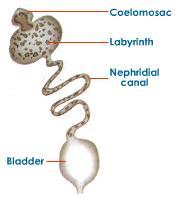Proteins consumed by living organisms for growth mainly consist of nitrogen. The metabolism of proteins, therefore, forms nitrogenous waste materials in the body that could be toxic in high quantities. It is important for living organisms to excrete nitrogenous waste products such as ammonia, urea, and uric acid. Based on the type of nitrogenous waste products, excreted, animals can be grouped into three main categories as follows:
- Ammonotelic– this is a group of animals that excretes nitrogenous waste materials in the form of ammonia. They include frogs and fishes.
- Ureotelic- this is a category of living things that excrete wastes from the metabolism of nitrogen in the form of urea. They include mammals which need less water.
- Urecotelic- a group of living things that excrete nitrogenous waste materials in the form of uric acid.
In this article, urecotelic organisms are discussed in detail.
Urecotelism.

The phenomenon of excretion of nitrogenous waste materials mainly in the form of uric acid and urates is called uricotelism.
Uricotelism is common in terrestrial animals such as insects, birds, and reptiles.
Formation of uric acid.
Uric acid is produced by the degradation of purines such as guanine in the kidney and liver to a certain extent. This process requires high energy levels.
Urecotelic animals use excess nitrogen to synthesize purines. Purines such as guanine or hypoxanthine are changed into xanthine, which further undergoes oxidation to form uric acid. Furthermore, parts of uric acid are oxidized to form allantoin and allantoic acid.
Allantoate, the hydration product of allantoin, is excreted by teleost fish. Most amphibians and fishes hydrolyze allantoate to glyoxylate and urea. Some of the marine invertebrates go a step further to hydrolyze urea to ammonia and carbon dioxide.
Amino acids in the liver are used to form creatine, which is used to produce creatinine. Production of uric acid from ammonia and its subsequent removal requires less amount of water because it is comparatively less soluble in water and less toxic in comparison to ammonia. Therefore, it is commonly observed in terrestrial animals with limited water access.
Uric acid test.
This test is used to determine by measuring the amount of uric acid in the blood. It also at times called serum urate or UA.
The test is important to prevent diseases that may arise from high levels of uric acids, such as:
- Gout: This is a type of arthritis such that crystals from uric acid form in joints and cause great pain. The pain can be felt in feet, ankles, knees, etc. the swelling, and joint discomfort limits range of motion.
- Kidney stones: Kidney stones are hard masses similar to small stones that form in kidneys due to high uric acid. They cause severe pain in the lower back, throwing up and blood in the urine.